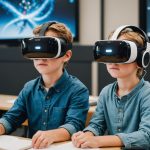The Historical Context of Virtual Reality in Education
Virtual reality (VR) has a fascinating history that intertwines with the evolution of education technology. Initially, the concept of VR emerged in the mid-20th century, primarily as a scientific and entertainment curiosity. Over time, its potential for transformative interactive learning became apparent, leading the way for its adoption in educational contexts.
The early adoption of VR in education was primarily experimental, driven by pioneering institutions eager to explore new education technology evolution. In the 1990s, universities and research labs began developing and integrating VR systems to enhance learning experiences, particularly in scientific and engineering fields. This period marked a shift towards more interactive learning, allowing students to engage with complex concepts through immersive 3D environments.
Additional reading : Revolutionizing Electric Vehicle Batteries: Breakthrough Innovations for Extended Range and Rapid Charging Solutions
Several key milestones and projects have shaped the path of VR in education. One notable project is the “Virtual Reality Roving Vehicle” created by NASA, which provided students with a virtual simulation of space missions. Such initiatives highlighted the potential of VR as a powerful educational tool, paving the way for future innovations.
As education technology evolution continued, VR became more accessible, with newer, affordable devices entering the market, further expanding its reach in classrooms worldwide. This progression has underscored VR’s role not only as a technological novelty but as a pivotal component of modern education strategy.
Topic to read : Unlocking Data Security: The Role of Quantum Cryptography in Safeguarding Government Operations
Current Trends in Virtual Reality for Learning
Virtual Reality (VR) is reshaping education by introducing dynamic immersive learning experiences. Now, students can engage with content like never before, making learning more interactive and enjoyable. Several popular VR platforms are being integrated into classrooms, bringing content to life. For instance, Google’s Expeditions allow students to embark on virtual field trips, exploring distant lands and historical sites from their desks.
Technological advancements have significantly improved the VR hardware and software utilized in educational settings. Devices like the Oculus Quest 2 provide untethered, high-quality VR experiences, while platforms such as Engage and AltspaceVR enhance connectivity and interactivity among users. These improvements ensure that VR in education is more than just a novelty—it is a tool that provides tangible benefits in student engagement and understanding.
An essential trend in VR for learning is its increasing accessibility. As technology becomes more affordable, a wider audience can access these pioneering tools. Schools and institutions are now more willing to invest in VR equipment, driven by its educational potential. This broadening availability ensures that more students, regardless of their socioeconomic status, can experience immersive learning. VR is not only revolutionizing how we learn today but also setting a precedent for future educational practices.
Case Studies Highlighting VR’s Impact in Education
Virtual Reality (VR) is revolutionising education by transforming interactive learning outcomes. Let’s delve into how various sectors are reaping benefits through VR case studies.
Success Stories from K-12 Education
In the K-12 arena, VR is beyond a gimmick; it’s a tool yielding significant educational benefits. An Atlanta school successfully integrated VR in history lessons, letting students ‘visit’ ancient Rome. This not only sparked curiosity but led to a 30% improvement in retention. Teachers noted that students were more engaged compared to traditional lectures, reflecting improved interactive learning outcomes.
Innovations in Higher Education
Universities are not left behind in harnessing VR’s potential. For instance, Stanford University applies VR for environmental studies. Virtual forest tours provide students with an immersive experience, enhancing understanding of complex ecological systems. Evidence suggests that such VR case studies offer deeper engagement, leading to better exam results and implementation success.
Corporate Training and VR Applications
In corporate sectors, companies like Walmart use VR to improve employee training. By simulating real-world scenarios, employees are better prepared for their roles. A trial run showed 20% efficiency improvement among participants. Educators and participants have expressed admiration for these programs, highlighting how VR ensures retention and measurable learning outcomes.
Benefits of Virtual Reality in Interactive Learning
Virtual Reality (VR) transforms interactive learning by offering educational benefits that traditional methods cannot match. One of the primary advantages is its ability to significantly increase learner engagement. Students become active participants in their education rather than passive recipients. VR immerses learners in environments where they can interact with content in a dynamic way, enhancing not just motivation but also retention.
Moreover, VR provides unparalleled opportunities for experiential learning. It enables students to practice skills in simulated settings, offering a safe space where mistakes become learning points rather than failures. For example, medical students can perform surgeries or pilots can test their skills in a simulated cockpit, all without the real-world consequences.
Another remarkable feature of VR in education is its ability to cater to both visual and kinaesthetic learners. By providing 3D, life-like visual displays and the ability to physically interact with content, VR supports diverse learning styles. This approach ensures that students who learn by seeing and doing can excel in subjects that might traditionally present challenges.
The practical applications of VR in education are numerous, reflecting a future where learning is more inclusive and effective through technology-driven experiences.
Challenges and Limitations of Implementing VR in Education
Implementing Virtual Reality (VR) in educational contexts faces distinct challenges, primarily financial. Acquiring VR technology requires significant investment, and schools must strategically allocate resources to afford this cutting-edge tool without sacrificing other essential educational needs. In financially constrained districts, purchasing VR equipment can seem impractical, creating a substantial barrier to implementation.
Beyond costs, effective VR integration necessitates robust teacher training and continuous professional development. Educators must gain not only technical proficiency with VR systems but also the pedagogical skills to leverage these technologies meaningfully within diverse learning scenarios. Without proper training, teachers may struggle, reducing VR’s educational impact.
Curriculum integration poses another challenge. Questions arise on how to harmonize VR with existing educational frameworks. Teachers and administrators must ensure that adopting VR enhances, rather than disrupts, learning methodologies. This requires thoughtful curriculum modifications and assessments to incorporate VR seamlessly, establishing its role in achieving educational objectives.
To overcome these education technology obstacles, schools should seek partnerships with tech providers for funding solutions and comprehensive training programs. Emphasising strategic planning ensures VR’s potential is maximized, translating into immersive, innovative learning experiences that enrich students’ educational journeys, despite prevalent implementation barriers.
Future Prospects of Virtual Reality in Education
The future of VR in education is a topic buzzing with potential and enthusiasm. Over the next decade, emerging technologies will significantly enhance VR capabilities, making educational experiences more immersive and engaging. Predictions suggest that VR could foster a transformation in traditional learning environments by creating interactive, three-dimensional experiences that are accessible to learners worldwide. This shift is likely to challenge educational innovation trends, pushing institutions to adopt new learning methodologies that focus on experiential learning.
The potential for VR to reshape educational methodologies lies in its ability to provide students with experiences that are otherwise inaccessible. Imagine learning about ancient civilizations by virtually exploring archaeological sites, or understanding complex scientific concepts through simulated experiments. This kind of learning can improve retention rates and encourage a deeper understanding of subjects.
Interdisciplinary approaches will play a crucial role in the development of VR, integrating fields such as psychology, computer science, and education to create more effective and human-centered learning tools. Collaborative efforts among educators, technologists, and psychologists are essential to harness the full potential of these emerging technologies. In this dynamic landscape, the adoption of VR in education promises to cultivate adaptable, forward-thinking learners who are better equipped to thrive in an ever-evolving world.













